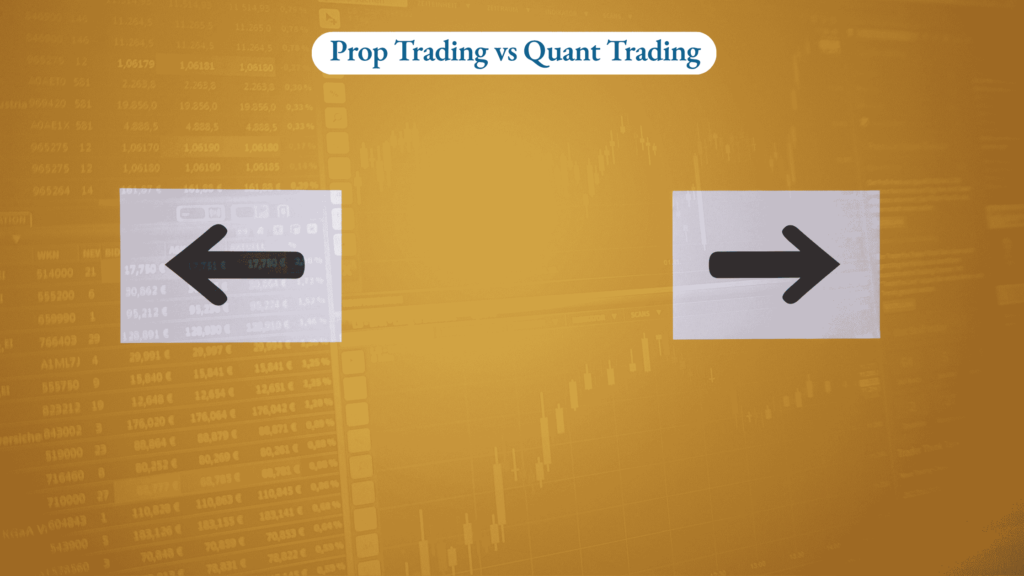Physical Address
304 North Cardinal St.
Dorchester Center, MA 02124
Explore the detailed analysis of prop trading vs quant trading in 2024. Learn how funded trader programs differ from institutional quant trading, with detailed insights on requirements, strategies, and earnings potential.

The landscape of professional trading has evolved dramatically in recent years, creating two distinct paths for aspiring traders: proprietary (prop) trading through funded accounts and quantitative (quant) trading. While both approaches offer significant earning potential, they differ fundamentally in their requirements, methodologies, and career trajectories.
In today’s market, prop trading has been revolutionized by firms like FTMO, FundedNext, and True Forex Funds, which provide traders with substantial capital after passing evaluations. Meanwhile, quant trading continues to dominate institutional trading floors, where mathematics and algorithms drive decision-making processes.
The concept of prop trading has undergone a significant transformation in recent years. Unlike traditional prop trading firms where traders worked in office locations, modern prop trading operates primarily through funded trader programs. These programs evaluate traders through a series of challenges before providing them with significant capital to trade.
The process typically begins with an evaluation phase, often called a “Challenge” or “Verification,” where traders must demonstrate their ability to generate profits while adhering to strict risk management rules. These evaluations usually require an initial fee, ranging from $300 to $1,000 or more, depending on the account size and program selected.
Once traders pass a prop firm evaluation, they gain access to funded accounts, often starting at $25,000 and scaling up to $200,000 or more. The beauty of this system lies in its profit-sharing structure, where traders typically keep 70-90% of their trading profits without risking their own capital beyond the initial evaluation fee. However, most prop firms don’t use real money for their trading programs.
Quantitative trading represents a fundamentally different approach to markets. Instead of discretionary decision-making based on chart patterns or market sentiment, quant trading relies on mathematical models and statistical analysis to identify trading opportunities.
Quant traders work within institutional settings, developing and implementing complex algorithms that can analyze vast amounts of market data in real-time. These systems often execute hundreds or thousands of trades per day, capitalizing on small price discrepancies or statistical patterns across multiple markets simultaneously.
The foundation of quant trading lies in its scientific approach to markets. Traders develop hypotheses about market behavior, test these hypotheses using historical data, and implement successful strategies through automated trading systems. This requires a deep understanding of both financial markets and advanced mathematics.

Modern prop trading has remarkably low barriers to entry in terms of formal education. Success depends more on practical trading skills and mental discipline than academic credentials. However, traders must develop:
Quant trading demands a much more rigorous academic background. Most successful quant traders possess:
Modern prop traders typically focus on liquid markets like forex, indices, or commodities. Their strategies often combine:
Technical Analysis:
Risk Management:
Quant traders develop systematic approaches that can be automated and scaled. Common strategies include:
The journey in prop trading typically follows this progression:
Earnings are directly tied to trading performance, with most firms offering 70-90% profit splits. Successful traders can earn substantial income, particularly when managing multiple funded accounts simultaneously.
Quant trading careers usually progress through:
Compensation includes base salaries starting at $150,000-$300,000, plus significant bonuses based on performance and firm profitability.
Selecting between prop and quant trading depends largely on your background, resources, and career goals. Prop trading offers a more accessible entry point with immediate earning potential but requires strict discipline and consistent performance. Quant trading provides a more structured career path with stable income but demands extensive education and technical expertise. You can also check out our guide on prop trading vs hedge funds to see how they compare.
For those with strong mathematical and programming skills who prefer a systematic approach to markets, quant trading offers an attractive career path. Conversely, those who excel at discretionary decision-making and prefer more flexible working conditions might find prop trading more suitable.
Both prop trading and quant trading offer viable paths to a career in financial markets. The democratization of prop trading through funded accounts has opened opportunities for talented traders regardless of their educational background. Meanwhile, quant trading continues to evolve with technological advancement, offering stable careers for those with strong technical skills.